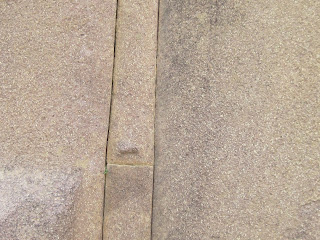Sunday, July 11, 2010
End of the Tour
We spent a few days of our vacation in Ollantaytambo. This made the most of our travels. It was more impressive to us than Machu Picchu but that could be because we had a better tour guide here than we did at Machu Picchu.
Inca Architecture
Across from the temple, on the opposite mountain, is a grain store house. The thought behind why the incas would have build a grain storage so high up a mountain is that the moisture was less and the grain would have lasted longer.

This bearded man is believed to be a traveler from Bolivia that brought grain and technology to the people of Ollantaytambo. The Tiahuanaco people in Bolivia had this stone carving and water technology prior to Ollantaytambo and Machu Pichuu. In the picture below, the bearded man is carrying a big bag on his back along with the grain store house.

In the picture below, you can see the profile of an inca emperor. When you look at this mountain, it seems there could be a lot more faces carved into it if you look long enough.
stone structure continued
Here is more carvings on the pink granite.

Here is the inca three levels (heaven, earth and underworld).

Here is the inca three levels (heaven, earth and underworld).
The guide showed us that the quary for the pink granite was at that mountain peak across the valley.
The stone would someone be taken from the quarry, brought down to the valley, then the incas would damn part of the river with and island in the middle. They would damn one side of the island so that the water would flow on the opposite side. Then they would move the boulders onto the island, un-damn the river and then damn the opposite side of the river and then bring the boulders across and up to the temple. This is all impressive and pretty unbelievable.
Saturday, July 10, 2010
More structure
Our guide pointed out that the incas always contured their construction to the layout of the land. In the first photo, you can see existing structure was built on top of with the pink granite instread of removing it. When looking around the temple, you will find different levels of complexity on the stones used for the structure. Some stones are just picked and placed while others were custom cut. The more complex cuts are the newer additions.


What's amazing about these pink granite rocks is that they are huge and were brought here from the next mountain over. In the images below, you can see some shapes protruding from the face of the blocks. It is believed that these were puma faces that were destroyed by the spanish priests. Peru use to have earthquakes and so the incas build relief joints into the wall.
Stone Structure
The stone work used in the building of the temple is unbelievable. There is no mortar used here. All these blocks are finely cut and interlocking. One guide had told us that they would make these cuts by chiseling out a small hole, then sticking a piece of wood in the hole, add water and sand then as the wood expanded, it would crack the rock. Maybe that was done by some but it seems to slow of a process to have been used for all these cuts.

Uncovering the site
What I noticed while walking around the site is that the entire base of the temple was buried by approximately two feet of soil. If you picked any spot and dug two feet down you would most likely find something. The site is still in work and unfortunately, it seems that there is no hurry to ever finish the work. I could never be an archeologist because this is way to slow of a process for me.

Water Duct
Throughout the ruins, you see amazing water canals. I wish they would restore the water flow throughout the ruins so that you can really get a feel of the city.


The Princess Bath
The princess bath was made of beautifully carved stone. You can see the three level symbolism carved into the rock. Throughout the inca ruins in Peru and the Tiahuanaco ruins in Bolivia, you will see the three levels of their belief system. The three levels were heaven, the present/living and the underworld. These were represented by the condor (heaven), the puma (present/living) and the snake (underworld).


If you look at the small pool at the top of the bath, our guide pointed out that the water flows from its source at an angle. The incas would put sand in that top small pool. As the water comes from its source, it will swirl around in the top pool to "filter" the water before it touches the princess. He put a leaf in the top pool and showed us that the leaf just circled around in the top pool.

The next thing he showed us was amazing. The engineering put into the design of this bath was amazing. The guide told us that the queen kneels in the pool with the water coming down on her head, she would simply run her fingers across the top of the fountain (where the guide is touching) and the water would stop flowing. She or someone would then flick water back at the fountain and the water will resume. I got video of this, its amazing.
The Baths
At the base of the ruins temple, are baths. Water for these baths comes from a "melting glacier" up the valley. The water is channeled through the stone under the ground. These baths were pretty interesting. Especially the princess bath.


The Tour
At the base of the ruins is a small town made up of the decenants of the incas. Just infront of the gates to the ruins is a small shopping area. We picked up a tour guide that spoke english.


As you look up the ruins, you see the agricultural terraces in front of you. Off to the left is the stair case up. Water use to be channeled from over the hill and come down through channels cut in the rock and flow through the terraces. When the spanish invaded, the incas dammed the flow of water so that the crops would die. Our guide also stated that modern engineers have not been able to figure out how to restart the flow of water through the terrances.
Ollantaytambo
We stayed one day in Ollantaytambo on our way to Machu Picchu. This town was small but I felt the stone work and civil engineering we saw here was more impressive than Machu Picchu. The pictures below are side views of the Ollantaytambo Ruins from our hostel.

Subscribe to:
Posts (Atom)


























